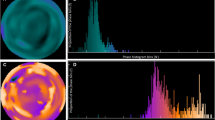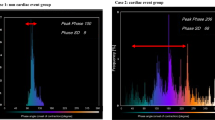Abstract
Background
The prognostic impact and pathophysiology of global left ventricular mechanical dyssynchrony (LVMD), namely mechanical dyssynchrony of whole left ventricle, as assessed by phase analysis of electrocardiographically gated (ECG-gated) myocardial perfusion SPECT has not been clearly elucidated in patients with dilated cardiomyopathy (DCM) and narrow QRS complex (<120 ms).
Methods and Results
Forty-six patients with DCM underwent ECG-gated myocardial 99mTc-sestamibi perfusion SPECT and endomyocardial biopsy. LV phase entropy was automatically calculated using a phase analysis of ECG-gated myocardial perfusion SPECT. The patients were divided into two groups according to the median phase entropy value: low-phase entropy (<0.61) (N = 23: LE group) and high-phase entropy (≥0.61) (N = 23: HE group). In the Kaplan-Meier survival analysis, the event-free survival rate was significantly lower in the HE group (log-rank P = 0.015). Moreover, high-phase entropy was an independent predictor of adverse cardiac events (hazard ratio, 5.77%; 95% confidence interval, 1.02-108.32; P = 0.047). Interestingly, the mRNA expression levels of sarcoplasmic reticulum Ca2+-ATPase (SERCA2a) in endomyocardial biopsy specimens were significantly lower in the HE group (P = 0.015).
Conclusion
LV phase entropy, which may reflect impairment of Ca2+ handling caused by decreased SERCA2a mRNA levels, is a novel prognostic predictor in patients with DCM and narrow QRS complex.




Similar content being viewed by others
Abbreviations
- BNP:
-
Brain natriuretic peptide
- DCM:
-
Dilated cardiomyopathy
- ECG:
-
Electrocardiogram
- HF:
-
Heart failure
- LV:
-
Left ventricular
- LVMD:
-
Left ventricular mechanical dyssynchrony
- NYHA:
-
New York Heart Association
- RT-PCR:
-
Reverse-transcriptase polymerase chain reaction
- SERCA2a:
-
Sarcoplasmic reticulum Ca2+-ATPase
- SPECT:
-
Single-photon emission computed tomography
References
Ushigome R, Sakata Y, Nochioka K, Miyata S, Miura M, Tadaki S, et al. Improved long-term prognosis of dilated cardiomyopathy with implementation of evidenced-based medication—report from the CHART studies. Circ J. 2015;79:1332–41.
Shenkman HJ, Pampati V, Khandelwal AK, McKinnon J, Nori D, Kaatz S, et al. Congestive heart failure and QRS duration: Establishing prognosis study. Chest. 2002;122:528–34.
Bader H, Garrigue S, Lafitte S, Reuter S, Jaïs P, Haïssaguerre M, et al. Intra-left ventricular electromechanical asynchrony. A new independent predictor of severe cardiac events in heart failure patients. J Am Coll Cardiol. 2004;43:248–56.
Chen J, Garcia EV, Folks RD, Cooke CD, Faber TL, Tauxe EL, et al. Onset of left ventricular mechanical contraction as determined by phase analysis of ECG-gated myocardial perfusion SPECT imaging: Development of a diagnostic tool for assessment of cardiac mechanical dyssynchrony. J Nucl Cardiol. 2005;12:687–95.
Beuckelmann DJ, Näbauer M, Erdmann E. Intracellular calcium handling in isolated ventricular myocytes from patients with terminal heart failure. Circulation. 1992;85:1046–55.
Elliott P, Andersson B, Arbustini E, Bilinska Z, Cecchi F, Charron P, et al. Classification of the cardiomyopathies: A position statement from the European Society Of Cardiology Working Group on myocardial and pericardial diseases. Eur Heart J. 2008;29:270–6.
Isobe S, Ohshima S, Unno K, Izawa H, Kato K, Noda A, et al. Relation of 99mTc-sestamibi washout with myocardial properties in patients with hypertrophic cardiomyopathy. J Nucl Cardiol. 2010;17:1082–90.
Okuda K, Nakajima K, Hosoya T, Ishikawa T, Matsuo S, Kawano M, et al. Quantification of myocardial perfusion SPECT using freeware package (cardioBull). Ann Nucl Med. 2011;25:571–9.
Nakajima K, Kumita S, Ishida Y, Momose M, Hashimoto J, Morita K, et al. Creation and characterization of Japanese standards for myocardial perfusion SPECT: Database from the Japanese Society of Nuclear Medicine Working Group. Ann Nucl Med. 2007;21:505–11.
Nakajima K, Okuda K, Nystrom K, Richter J, Minarik D, Wakabayashi H, et al. Improved quantification of small hearts for gated myocardial perfusion imaging. Eur J Nucl Med Mol Imaging. 2013;40:1163–70.
Nakajima K, Okuda K, Matsuo S, Kiso K, Kinuya S, Garcia EV. Comparison of phase dyssynchrony analysis using gated myocardial perfusion imaging with four software programs: Based on the Japanese Society of Nuclear Medicine working group normal databese. J Nucl Cardiol. 2016. doi:10.1007/s12350-015-0333-y.
Takahashi N, Yamamoto A, Tezuka S, Ishikawa M, Abe J, Amitani K, et al. Assessment of left ventricular dyssynchrony during development of heart failure by a novel program using ECG-gated myocardial perfusion SPECT. Circ J. 2008;72:370–7.
Izawa H, Yokota M, Takeichi Y, Inagaki M, Nagata K, Iwase M, et al. Adrenergic control of the force-frequency and relaxation-frequency relations in patients with hypertrophic cardiomyopathy. Circulation. 1997;96:2959–68.
Somura F, Izawa H, Iwase M, Takeichi Y, Ishiki R, Nishizawa T, et al. Reduced myocardial sarcoplasmic reticulum Ca(2+)-ATPase mRNA expression and biphasic force-frequency relations in patients with hypertrophic cardiomyopathy. Circulation. 2001;104:658–63.
Sutton MS, Keane MG. Reverse remodelling in heart failure with cardiac resynchronisation therapy. Heart. 2007;93:167–71.
Kashani A, Barold SS. Significance of QRS complex duration in patients with heart failure. J Am Coll Cardiol. 2005;46:2183–92.
Iuliano S, Fisher SG, Karasik PE, Fletcher RD, Singh SN. Failure DoVASToATiCH. QRS duration and mortality in patients with congestive heart failure. Am Heart J. 2002;143:1085–91.
Sandhu R, Bahler RC. Prevalence of QRS prolongation in a community hospital cohort of patients with heart failure and its relation to left ventricular systolic dysfunction. Am J Cardiol. 2004;93:244–6.
Hawkins NM, Petrie MC, MacDonald MR, Hogg KJ, McMurray JJ. Selecting patients for cardiac resynchronization therapy: Electrical or mechanical dyssynchrony? Eur Heart J. 2006;27:1270–81.
Yu CM, Lin H, Zhang Q, Sanderson JE. High prevalence of left ventricular systolic and diastolic asynchrony in patients with congestive heart failure and normal QRS duration. Heart. 2003;89:54–60.
Cho GY, Song JK, Park WJ, Han SW, Choi SH, Doo YC, et al. Mechanical dyssynchrony assessed by tissue Doppler imaging is a powerful predictor of mortality in congestive heart failure with normal QRS duration. J Am Coll Cardiol. 2005;46:2237–43.
Uebleis C, Hellweger S, Laubender RP, Becker A, Sohn HY, Lehner S, et al. Left ventricular dyssynchrony assessed by gated SPECT phase analysis is an independent predictor of death in patients with advanced coronary artery disease and reduced left ventricular function not undergoing cardiac resynchronization therapy. Eur J Nucl Med Mol Imaging. 2012;39:1561–9.
Soman P, Chen J. Left ventricular dyssynchrony assessment using myocardial single-photon emission CT. Semin Nucl Med. 2014;44:314–9.
Van Kriekinge SD, Nishina H, Ohba M, Berman DS, Germano G. Automatic global and regional phase analysis from gated myocardial perfusion SPECT imaging: Application to the characterization of ventricular contraction in patients with left bundle branch block. J Nucl Med. 2008;49:1790–7.
O’Connell JW, Schreck C, Moles M, Badwar N, DeMarco T, Olgin J, et al. A unique method by which to quantitate synchrony with equilibrium radionuclide angiography. J Nucl Cardiol. 2005;12:441–50.
Katz AM. Cardiomyopathy of overload. A major determinant of prognosis in congestive heart failure. N Engl J Med. 1990;322:100–10.
Flesch M, Schwinger RH, Schnabel P, Schiffer F, van Gelder I, Bavendiek U, et al. Sarcoplasmic reticulum Ca2+ ATPase and phospholamban mRNA and protein levels in end-stage heart failure due to ischemic or dilated cardiomyopathy. J Mol Med (Berl). 1996;74:321–32.
Vanderheyden M, Mullens W, Delrue L, Goethals M, de Bruyne B, Wijns W, et al. Myocardial gene expression in heart failure patients treated with cardiac resynchronization therapy responders versus nonresponders. J Am Coll Cardiol. 2008;51:129–36.
Arai M, Alpert NR, MacLennan DH, Barton P, Periasamy M. Alterations in sarcoplasmic reticulum gene expression in human heart failure. A possible mechanism for alterations in systolic and diastolic properties of the failing myocardium. Circ Res. 1993;72:463–9.
Acknowledgements
This work was supported in part by Japanese Society for the Promotion of Science KAKENHI Grant No. 25860594 (TO).
Disclosures
N K. has nothing to declare. T.O. received lecture fees from Otsuka and research grants from Ono Yakuhin, Bayer, and Daiichi Sankyo. S.I. received lecture fee from FUJIFILM RI Farma. A.S. has nothing to declare. N.W. has nothing to declare. K. F. has nothing to declare. H. M. has nothing to declare. R.M. belongs to a development endowed by Chugai, Dainippon Sumitomo, Kowa, Kyowa Hakko Kirin, MSD, Nihon Medi-physics, and Nippon Boehringer Ingelheim. K.K. has nothing to declare. Y.B. received lecture fees and research grants from Asteras, AstraZeneca, Boehringer Ingelheim, MSD, Takeda, and Tanabe-Mitsubishi. T.M. received lecture fees and research grants from Astellas, AstraZeneca, Bayer, Boehringer Ingelheim, Daiichi Sankyo, Otsuka, Teijin, Sanofi-aventis, Kowa, Dainippon Sumitomo, Novartis, MSD, Pfizer, Takeda, and Tanabe-Mitsubishi.
Author information
Authors and Affiliations
Corresponding author
Additional information
The authors of this article have provided a PowerPoint file, available for download at SpringerLink, which summarises the contents of the paper and is free for re-use at meetings and presentations. Search for the article DOI on SpringerLink.com.
Electronic supplementary material
Below is the link to the electronic supplementary material.
Rights and permissions
About this article
Cite this article
Kano, N., Okumura, T., Isobe, S. et al. Left ventricular phase entropy: Novel prognostic predictor in patients with dilated cardiomyopathy and narrow QRS. J. Nucl. Cardiol. 25, 1677–1687 (2018). https://doi.org/10.1007/s12350-017-0807-1
Received:
Accepted:
Published:
Issue Date:
DOI: https://doi.org/10.1007/s12350-017-0807-1




